Impact of Urbanization on Eco-Efficiency of Tourism Destinations
Abstract
:1. Introduction
2. Methodology
2.1. Research Object and Framework
2.1.1. Research Object
2.1.2. Framework
2.2. Methods and Models
2.2.1. Research Method
2.2.2. Data Source
2.2.3. Model
2.3. Index System and Data Source
2.3.1. Economic Efficiency and Eco-Efficiency Index System of Tourism Destinations
2.3.2. Influencing Factor Index System
3. Results
3.1. Overall Trend
3.2. Spatial Distribution Pattern of Efficiency of Tourism Destinations
3.3. Coupling Analysis of Urbanization of Tourism Destinations with Economic Efficiency and Eco-Efficiency in China
3.4. Analysis of Driving Factors of Eco-Efficiency of Tourism Destinations in China
3.4.1. First-Stage Regression
3.4.2. Second-Stage Regression
4. Conclusions and Discussion
4.1. Conclusions
4.2. Discussion
5. Implications and Limitations
5.1. Implications
5.2. Limitations
Author Contributions
Funding
Institutional Review Board Statement
Informed Consent Statement
Data Availability Statement
Acknowledgments
Conflicts of Interest
References
- UNWTO. Tourism and the Sustainable Development Goals—Journey to 2030; UNWTO: Madrid, Spain, 2017. [Google Scholar]
- Peter, M. Tourism Impacts, Planning and Management; Taylor and Francis: Abingdon, UK, 2015. [Google Scholar]
- Ho, D.T. Carbon dioxide removal is an ineffective time machine. Nature 2023, 616, 9. [Google Scholar] [CrossRef] [PubMed]
- Cooper, C. Essentials of Tourism; SAGE: Thousand Oaks, CA, USA, 2021. [Google Scholar]
- Lenzen, M.; Sun, Y.-Y.; Faturay, F.; Ting, Y.-P.; Geschke, A.; Malik, A. The carbon footprint of global tourism. Nat. Clim. Change 2018, 8, 544. [Google Scholar] [CrossRef] [Green Version]
- UNWTO. Glossary of Tourism Terms|UNWTO. 2008. Available online: https://www.unwto.org/glossary-tourism-terms (accessed on 9 July 2023).
- Wang, L.-E.; Tian, B.; Filimonau, V.; Ning, Z.; Yang, X. The impact of the COVID-19 pandemic on revenues of visitor attractions: An exploratory and preliminary study in China. Tour. Econ. 2022, 28, 153–174. [Google Scholar] [CrossRef]
- 308 Million Domestic Tourism Trips during the 2023 Spring Festival Holiday. 2023. Available online: http://www.gov.cn/xinwen/2023-01/27/content_5738862.htm#1 (accessed on 27 April 2023).
- Liao, Z.; Jin, M.; Ren, P.; Luo, Y. Research on Scenic Spot’s Sustainable Development Based on a SD Model: A Case Study of the Jiuzhai Valley. Sustainability 2014, 6, 4632–4644. [Google Scholar] [CrossRef] [Green Version]
- Morrison, A.M. Managing and Marketing Tourism Destinations; Taylor and Francis: Abingdon, UK, 2018. [Google Scholar]
- Kolar, T. Conceptualising tourist experiences with new attractions: The case of escape rooms. Int. J. Contemp. Hosp. Manag. 2017, 29, 1322–1339. [Google Scholar] [CrossRef]
- Gong, J.; Detchkhajornjaroensri, P.; Knight, D.W. Responsible tourism in Bangkok, Thailand: Resident perceptions of Chinese tourist behaviour. Int. J. Tour. Res. 2019, 21, 221–233. [Google Scholar] [CrossRef]
- Lee, E. Types and Characteristics of Tourist attractions in the Central Region: Focusing on New Scenic Spot Classification Criteria. J. Korean Geogr. Soc. 2019, 54, 35–49. [Google Scholar]
- Shi, H.; Shi, T.; Liu, Q.; Wang, Z. Ecological Vulnerability of Tourism Scenic Spots: Based on Remote Sensing Ecological Index. Pol. J. Environ. Stud. 2021, 30, 3231–3248. [Google Scholar] [CrossRef]
- Ding, H.; He, M.; Deng, C. Lifecycle approach to assessing environmental friendly product project with internalizing environmental externality. J. Clean. Prod. 2014, 66, 128–138. [Google Scholar] [CrossRef]
- Hu, W.; Liu, J.; Li, M.; Zhu, L. Exploration of Substitute Industry for Shanxi’s Coal Economy: On the Path of Key Scenic Spots Propelling Regional Economic Development. China Popul. Resour. Environ. 2016, 26, 168–176. [Google Scholar]
- Zhang, R.; Pu, L. Influence of tourism development on the eco-environment of tourist attractions and countermeasures for tourism development management. J. Environ. Prot. Ecol. 2020, 21, 2323–2332. [Google Scholar]
- Ma, D.; Xia, H.L. Analysis of the impact of water pollution on tourism activities in tourist attractions under the concept of ecological environment protection. Fresenius Environ. Bull. 2021, 30, 9966–9971. [Google Scholar]
- Zhu, F.; Shen, W.; Diao, J.; Li, M.; Zheng, G. Integrating cross-sensor high spatial resolution satellite images to detect subtle forest vegetation change in the Purple Mountains, a national scenic spot in Nanjing, China. J. For. Res. 2020, 31, 1743–1758. [Google Scholar] [CrossRef] [Green Version]
- Han, W.; Chen, X. Magnetic Properties of Topsoils and Their Environmental Implications in Kanas Scenic Spot of Xinjiang, China. Soils 2019, 51, 185–194. [Google Scholar]
- Susanne, B.; John, H. Climate Change and Tourism: From Policy to Practice; Taylor and Francis: Abingdon, UK, 2012. [Google Scholar]
- Liu, L. Impacts of tourism development and tourist activities on environment in scenic ecotourism spots. Appl. Ecol. Environ. Res. 2019, 17, 9347–9355. [Google Scholar] [CrossRef]
- Yang, M.-Y.; Van Coillie, F.; Hens, L.; De Wulf, R.; Ou, X.-K.; Zhang, Z.-M. Nature conservation versus scenic quality: A GIS approach towards optimized tourist tracks in a protected area of Northwest Yunnan, China. J. Mt. Sci. 2014, 11, 142–155. [Google Scholar] [CrossRef]
- Wang, J. Study on spatial econometrics of regional economic development under development of ecological. Fresenius Environ. Bull. 2020, 29, 9511–9521. [Google Scholar]
- Ye, X.; Miao, L. Research on Decision-Making Based on the Three-Party Evolutionary Game of Tourists, Tourist attractions, and Government. J. Organ. End User Comput. 2022, 34, 23. [Google Scholar] [CrossRef]
- Huang, T.; Liu, J.L.; Tang, N.; Zhang, T. The influence of values and scenic spot’s policy on tourists’ environmentally responsible behavior: An extended theory of planned behavior model. J. Arid Land Resour. Environ. 2018, 32, 88–94. [Google Scholar]
- Bai, S.Z.; Han, F.L. Tourist Behavior Recognition through Scenic Spot Image Retrieval Based on Image Processing. Trait. Du Signal 2020, 37, 619–626. [Google Scholar] [CrossRef]
- Fan, Q.; Sun, T. Discussion on the Sustainable Development of Scenic Spots. In Proceedings of the 2nd International Conference on Engineering and Business Management, Wuhan, China, 22–24 March 2011. [Google Scholar]
- Li, X.; Zhang, J.; Jiang, N.; Zhao, T.; Yang, F. An Evaluation Method of Scenic Spots Based on Location Check-in Data and Classified Information of Tourist attractions. J. Geomat. Sci. Technol. 2015, 32, 405–411. [Google Scholar]
- Jian-dong, Z.; Hao, W. Study on environmental capacity of the city tourist attractions based on sustainable development: A case study of Yangzhou Slender West Lake tourist attractions. J. Yangzhou Univ. 2009, 30, 95–99. [Google Scholar]
- Xia, B.; Dong, S.; Li, Z.; Zhao, M.; Sun, D.; Zhang, W.; Li, Y. Eco-Efficiency and Its Drivers in Tourism Sectors with Respect to Carbon Emissions from the Supply Chain: An Integrated EEIO and DEA Approach. Int. J. Environ. Res. Public Health 2022, 19, 6951. [Google Scholar] [CrossRef] [PubMed]
- McKercher, B.; Prideaux, B. Tourism Theories, Concepts and Models; Goodfellow: Delson, QC, Canada, 2020. [Google Scholar]
- Ren, Y. The Upgrading of Urbanization and China’s New Urbanization. Urban Plan. Forum 2016, 2, 66–71. [Google Scholar]
- Zhu, J.G.; Xu, J.W.; Li, X.J.; Lou, F.; Chen, Y. Impact of Land Urbanization and Population Urbanization on Economic Growth in China. Sci. Geogr. Sin. 2020, 40, 1654–1662. [Google Scholar]
- Brown, L.M.; Graham, C.H. Demography, traits and vulnerability to urbanization: Can we make generalizations? J. Appl. Ecol. 2015, 52, 1455–1464. [Google Scholar] [CrossRef] [Green Version]
- Shuai, L.I.; Guangjun, X.U. An urbanization model of the opening Chinese economy. J. Beijing Univ. Chem. Technol. 2006, 33, 78–81. [Google Scholar]
- Chen, M.; Ye, C.; Lu, D.; Sui, Y.; Guo, S. Cognition and construction of the theoretical connotations of new urbanization with Chinese characteristics. J. Geogr. Sci. 2019, 29, 1681–1698. [Google Scholar] [CrossRef] [Green Version]
- Chen, M.; Lu, D.; Zha, L. The comprehensive evaluation of China’s urbanization and effects on resources and environment. J. Geogr. Sci. 2010, 20, 17–30. [Google Scholar] [CrossRef]
- UNESCO. Regional Office for Education in Asia and the Pacific. Population, migration and urbanization. Bull. Unesco Reg. Off. Educ. Asia Pac. 1982, 23, 289–313. [Google Scholar]
- Luo, W.; Bai, H.; Jing, Q.; Liu, T.; Xu, H. Urbanization-induced ecological degradation in Midwestern China: An analysis based on an improved ecological footprint model. Resour. Conserv. Recycl. 2018, 137, 113–125. [Google Scholar] [CrossRef]
- Singh, H.; Garg, R.; Karnatak, H.C.; Roy, A. Spatial landscape model to characterize biological diversity using R statistical computing environment. J. Environ. Manag. 2018, 206, 1211–1223. [Google Scholar] [CrossRef] [PubMed]
- Liang, W.; Yang, M. Urbanization, economic growth and environmental pollution: Evidence from China. Sustain. Comput. Inform. Syst. 2019, 21, 1–9. [Google Scholar] [CrossRef]
- Yang, Y. Agglomeration Density and Labor Productivity in China’s Tourism Industry. Int. J. Tour. Res. 2016, 18, 434–446. [Google Scholar] [CrossRef]
- Zhu, H.; Chen, X.L. Space Distribution Structure of A-grade Scenic Spot in China. Sci. Geogr. Sin. 2008, 28, 607–615. [Google Scholar]
- Li, H.; Li, D.; Dong, X.; Xu, N. Spatial patterns of 5A-level tourist attractions and their network attention degrees in China. J. Arid Land Resour. Environ. 2019, 33, 178–184. [Google Scholar]
- Zhang, G.-H.; Yuan, H.-Y.; Duan, R.-X.; Dong, Y.-L. Multiscale analysis of the spatiotemporal differences and the influencing factors of the high-level in China. J. Nat. Resour. 2022, 37, 2672–2687. [Google Scholar]
- Chen, M.; Gong, Y.; Li, Y.; Lu, D.; Zhang, H. Population distribution and urbanization on both sides of the Hu Huanyong Line: Answering the Premier’s question. J. Geogr. Sci. 2016, 26, 1593–1610. [Google Scholar] [CrossRef]
- Peeters, A.; Zude, M.; Käthner, J.; Ünlü, M.; Kanber, R.; Hetzroni, A.; Gebbers, R.; Ben-Gal, A. Getis-Ord’s hot- and cold-spot statistics as a basis for multivariate spatial clustering of orchard tree data. Comput. Electron. Agric. 2015, 111, 140–150. [Google Scholar] [CrossRef]
- Bornmann, L.; de Moya Angeon, F. Hot and cold spots in the US research: A spatial analysis of bibliometric data on the institutional level. J. Inf. Sci. 2019, 45, 84–91. [Google Scholar] [CrossRef]
- Yan, Y.; Qu, J.; Hao, X.; Yue, S. Characterizing spatial-temporal changes of heat waves in China using center of gravity analysis. Phys. Geogr. 2017, 38, 379–391. [Google Scholar] [CrossRef]
- Zhang, Y.; Zhang, J.; Yang, Z.; Li, J. Analysis of the distribution and evolution of energy supply and demand centers of gravity in China. Energy Policy 2012, 49, 695–706. [Google Scholar] [CrossRef]
- Chu, Y.; Zhao, Z. Coupling analysis on the top 100 tourist attractions system and tourism industry development in China. J. Arid Land Resour. Environ. 2013, 27, 187–190. [Google Scholar]
- Lan, Z.H.; Ping, Y.X.; Fang, H.; Hui, S.; Rong, W.C.; Jiao, G.J. Analysis and forecast of coupling situation among tourism industry-economic development-ecological environment in Xinjiang. Arid Land Geogr. 2020, 43, 1146–1154. [Google Scholar]
- Zheng, D.C.; Liu, W.X.; Li, X.X.; Lin, Z.Y.; Jiang, H. Research on carbon emission diversity from the perspective of urbanization. Appl. Ecol. Environ. Res. 2018, 16, 6643–6654. [Google Scholar] [CrossRef]
- China’s Economic and Social Big Data Research Platform. Available online: https://data.cnki.net/yearBook/single?id=N2022060061 (accessed on 1 April 2023).
- China’s Economic and Social Big Data Research Platform. Available online: https://data.cnki.net/yearBook/single?id=N2018020050 (accessed on 1 April 2023).
- China’s Economic and Social Big Data Research Platform. Available online: https://data.cnki.net/yearBook/single?id=N2021110004 (accessed on 1 April 2023).
- The National Bureau of Statistics of China. Available online: https://data.stats.gov.cn/easyquery.htm?cn=C01 (accessed on 9 April 2023).
- China’s Economic and Social Big Data Research Platform. Available online: https://data.cnki.net/yearBook/single?id=N2021030182 (accessed on 1 April 2023).
- Huang, C.-W.; Chen, H.-Y.; Ting, C.-T. Using a network data envelopment analysis model to assess the efficiency and effectiveness of cultural tourism promotion in Taiwan. J. Travel Tour. Mark. 2017, 34, 1274–1284. [Google Scholar] [CrossRef]
- Yong, L.I.U.; Zhi-Xiang, L.I.; Jing, L.I. Environmental Efficiency Assessment Based on SBM-NS Model. Math. Pract. Theory 2009, 39, 25–30. [Google Scholar]
- Louzada, F.; Ferreira, P.H. Modified inference function for margins for the bivariate clayton copula-based SUN Tobit Model. J. Appl. Stat. 2016, 43, 2956–2976. [Google Scholar] [CrossRef]
- Song, W. Distribution-free test in Tobit mean regression model. J. Stat. Plan. Inference 2011, 141, 2891–2901. [Google Scholar] [CrossRef]
- Wang, Z. Jokhang Scenic Spot Bearing Capacity Evaluation Index System Construction. Chin. Agric. Sci. Bull. 2012, 28, 187–192. [Google Scholar]
- Li, Y.; Zhang, L. Ecological efficiency management of tourism based on carbon footprint analysis. Int. J. Low-Carbon Technol. 2020, 15, 550–554. [Google Scholar] [CrossRef]
- Ullah, M.I.; Aslam, M.; Altaf, S.; Ahmed, M. Some New Diagnostics of Multicollinearity in Linear Regression Model. Sains Malays. 2019, 48, 2051–2060. [Google Scholar] [CrossRef]
- Kroll, C.N.; Song, P. Impact of multicollinearity on small sample hydrologic regression models. Water Resour. Res. 2013, 49, 3756–3769. [Google Scholar] [CrossRef]
- Wang, R.; Xia, B.; Dong, S.; Li, Y.; Li, Z.; Ba, D.; Zhang, W. Research on the Spatial Differentiation and Driving Forces of Eco-Efficiency of Regional Tourism in China. Sustainability 2021, 13, 280. [Google Scholar] [CrossRef]
- Hu, M.J.; Ding, Z.S.; Li, Z.J.; Zhou, N.X.; Li, X.; Zhang, C. Tourism ecological welfare and driving factors from the perspective of ecological efficiency: A case study of Changzhou City. Acta Ecol. Sin. 2020, 40, 1944–1955. [Google Scholar]
- GB/T 39497-2020; New-type urbanization—Evaluation index system of quality city. China National Institute of Standardization: Beijing, China, 2020.
- Xiong, G.B.; Deng, J.H.; Ding, B.G. Characteristics, decoupling effect, and driving factors of regional tourism’s carbon emissions in China. Environ. Sci. Pollut. Res. 2022, 29, 47082–47093. [Google Scholar] [CrossRef]
- Zhang, J.; Zhang, Y. Tourism and regional carbon emissions: City-level evidence from China. Tour. Rev. 2023, 78, 888–906. [Google Scholar] [CrossRef]
- National Standard Retrieval: National Standard Information Public Service Platform. Available online: https://std.samr.gov.cn/search/std?q=GB%2FT%2017775-2003 (accessed on 9 July 2023).
- Wang, W.; Wang, W.J.; Li, J.S.; Wu, H.; Xu, C.; Liu, T. The Impact of Sustained Drought on Vegetation Ecosystem in Southwest China Based on Remote Sensing. Procedia Environ. Sci. 2010, 2, 1679–1691. [Google Scholar] [CrossRef] [Green Version]
- Huang, S.; Wei, X. Offline versus online travel experience sharing: The national profile of China. Int. J. Cult. Tour. Hosp. Res. 2019, 13, 183–189. [Google Scholar] [CrossRef] [Green Version]
- Yao, Z.; Chen, T. Tourism Eco-efficiency Model and an Empirical Research. China Popul. Resour. Environ. 2015, 25, 113–120. [Google Scholar]
- Tian, D.; Liu, J.; Zhong, L.; Wang, R.; Wang, J. Research on eco-tourism image positioning: Case of Qinghai Lake. J. Arid Land Resour. Environ. 2012, 26, 181–188. [Google Scholar]
- Guo, J.K.; Wang, S.B.; Wang, H. Comprehensive Measure of the Regional Advantages of National Scenic Area. Econ. Geogr. 2017, 37, 187–195. [Google Scholar]
- Zha, J.; Dai, J.; Xu, H.; Zhao, C.; Tan, T.; Li, Z. Assessing efficiency and determinants of tourist attractions based on a two-subprocess perspective: A case of Chengdu, southwestern China. J. Destin. Mark. Manag. 2021, 19, 100542. [Google Scholar] [CrossRef]
- Xianglin, L.U. Canonical Correlation Analysis of Input-output of Chinese Tourism Development. J. Anhui Agric. Sci. 2007, 35, 3721–3722. [Google Scholar]
- Liu, Y.H.; Gao, C.C.; Lu, Y.Y. The impact of urbanization on GHG emissions in China: The role of population density. J. Clean. Prod. 2017, 157, 299–309. [Google Scholar] [CrossRef]
- Xu, Y.; Zhang, R.; Fan, X.; Wang, Q. How does green technology innovation affect urbanization? An empirical study from provinces of China. Environ. Sci. Pollut. Res. 2022, 29, 36626–36639. [Google Scholar] [CrossRef]
- Jin, H.; He, Y.; Zhao, C. Social Security Expenditure, Demographic Structural Changes, and Urban-Rural Income Gap in China: Evidence from the Provincial Data. Rev. De Cercet. Si Interv. Soc. 2018, 62, 254–277. [Google Scholar]
- Dai, W.; He, J. Comprehensive Evaluation on the Quality of Population Urbanization and Its Policy Implication: A Case of Anhui Province. Urban Stud. 2020, 27, 32–36. [Google Scholar]
- Shuancheng, L.I.; Zhiqiang, Z.; Yanglin, W. Urbanization Process and Effects of Natural Resource and Environment in China: Research Trends and Future Directions. Prog. Geogr. 2009, 28, 63–70. [Google Scholar]
- Zhao, P.; Duan, B.Y.-C.; Zhang, Y.; Yang, Y.; Zhang, W.; Fang, Y.; Liu, Y. A comparison of the early impact of government restriction and risk perception on tourist attraction demand during the COVID-19 pandemic. Asia Pac. J. Tour. Res. 2022, 27, 1286–1303. [Google Scholar] [CrossRef]
- Peng, H.; Zhang, J.; Lu, L.; Tang, G.; Yan, B.; Xiao, X.; Han, Y. Eco-efficiency and its determinants at a tourism destination: A case study of Huangshan National Park, China. Tour. Manag. 2017, 60, 201–211. [Google Scholar] [CrossRef]
- Weng, G.; Li, C.; Pan, Y.; Li, J. Decoupling Effect and Influencing Factors of Carbon Emissions in China’s Tourism Industry. Geogr. Geo-Inf. Sci. 2021, 37, 114–120. [Google Scholar]
- Liobikiene, G.; Butkus, M. Scale, composition, and technique effects through which the economic growth, foreign direct investment, urbanization, and trade affect greenhouse gas emissions. Renew. Energy 2019, 132, 1310–1322. [Google Scholar] [CrossRef]
- Li, T.C.; Shi, Z.Y.; Han, D.R. Research on the impact of energy technology innovation on total factor ecological efficiency. Environ. Sci. Pollut. Res. 2022, 29, 37096–37114. [Google Scholar] [CrossRef]
- Hong, Z.; Wang, L.; Zhang, C. Influencing factors of regional tourism eco-efficiency under the background of green development in the western China. Acta Ecol. Sin. 2021, 41, 3512–3524. [Google Scholar]
- Jiang, Z.Q. Action mechanism of environmental institution on urban ecological efficiency. J. Environ. Prot. Ecol. 2022, 23, 2474–2484. [Google Scholar]
- Ahmed, K.; Shahbaz, M.; Kyophilavong, P. Revisiting the emissions-energy-trade nexus: Evidence from the newly industrializing countries. Environ. Sci. Pollut. Res. 2016, 23, 7676–7691. [Google Scholar] [CrossRef] [PubMed]
- Shao, L.G.; Yu, X.; Feng, C. Evaluating the eco-efficiency of China’s industrial sectors: A two-stage network data envelopment analysis. J. Environ. Manag. 2019, 247, 551–560. [Google Scholar] [CrossRef]


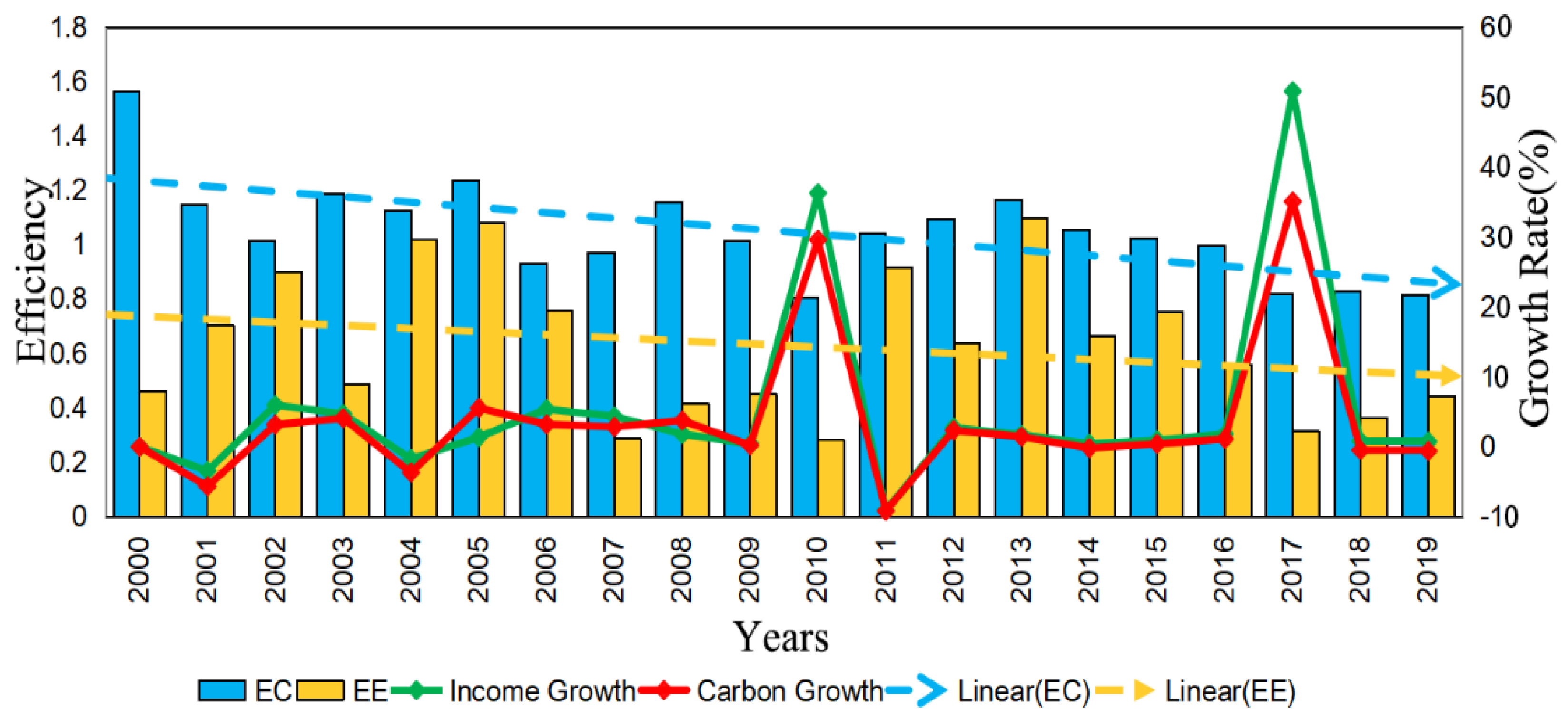
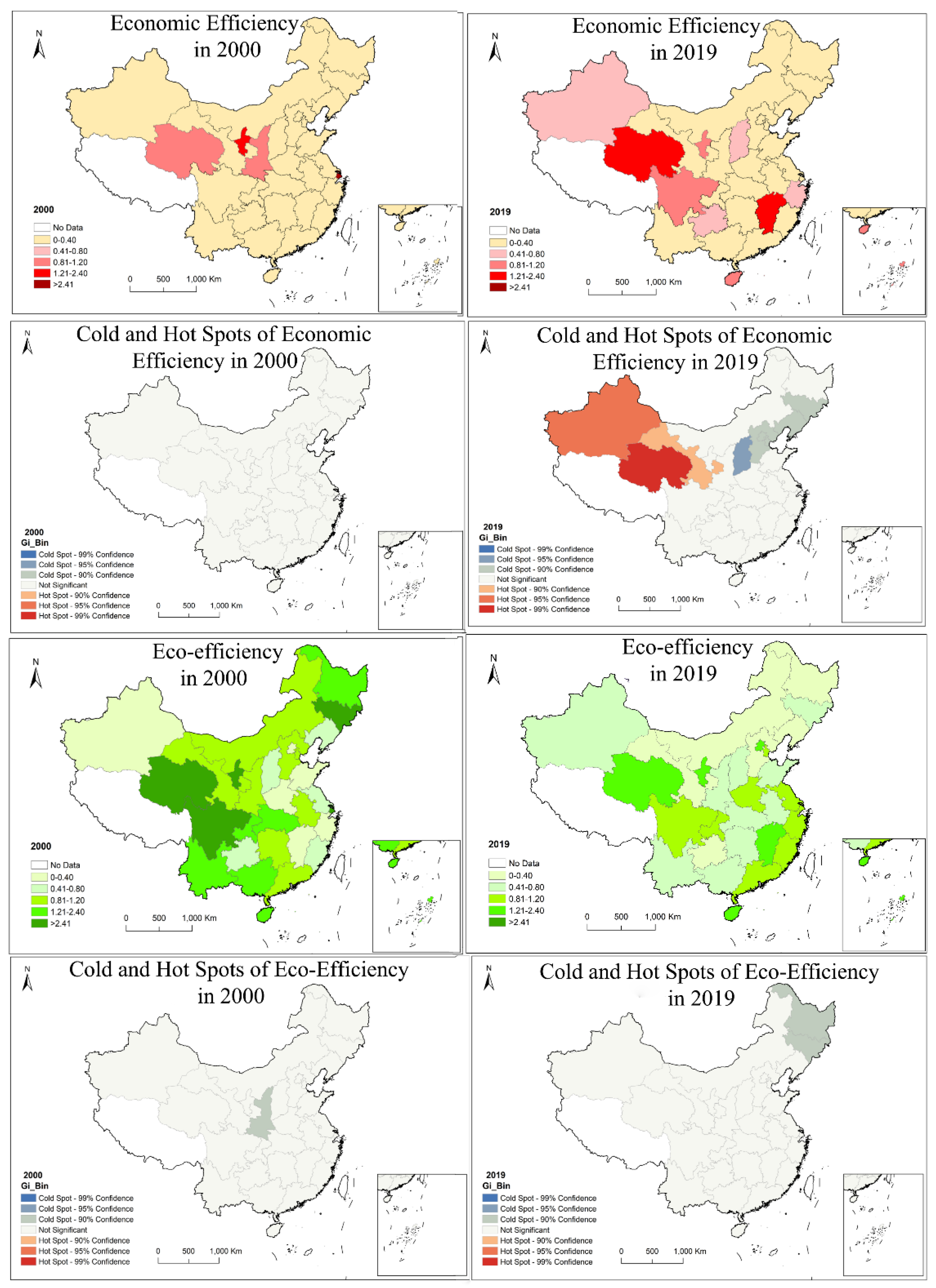
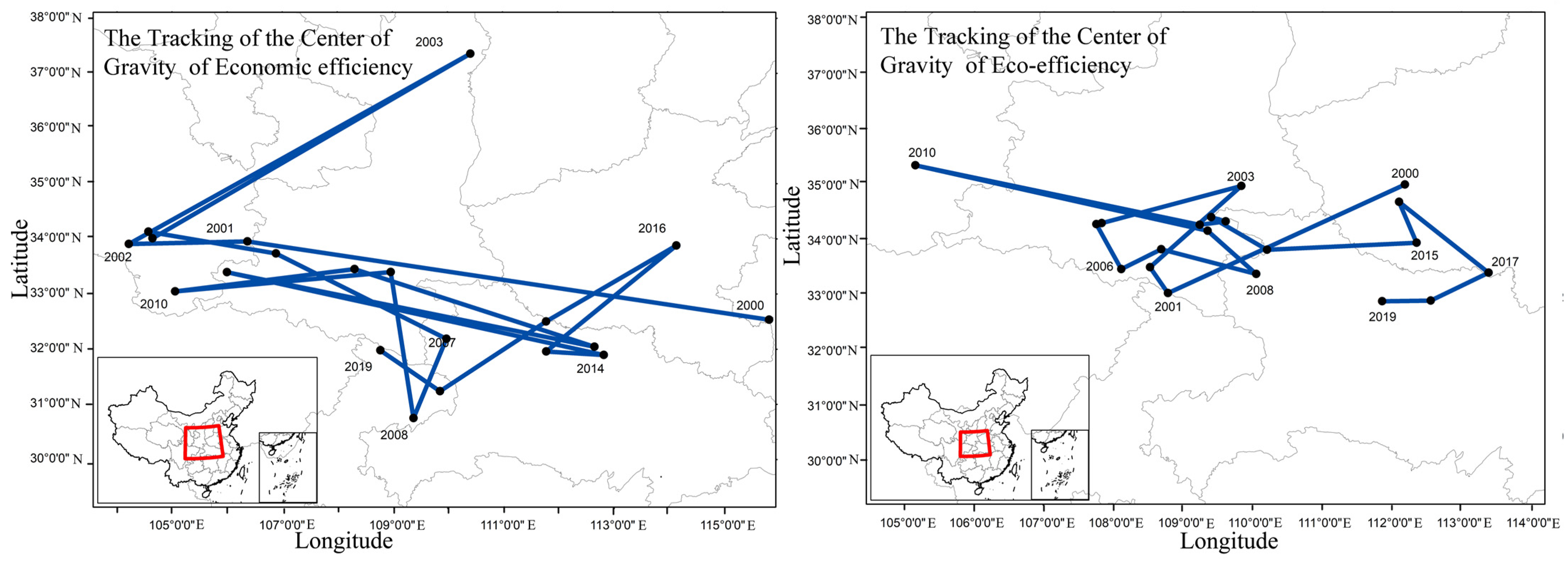
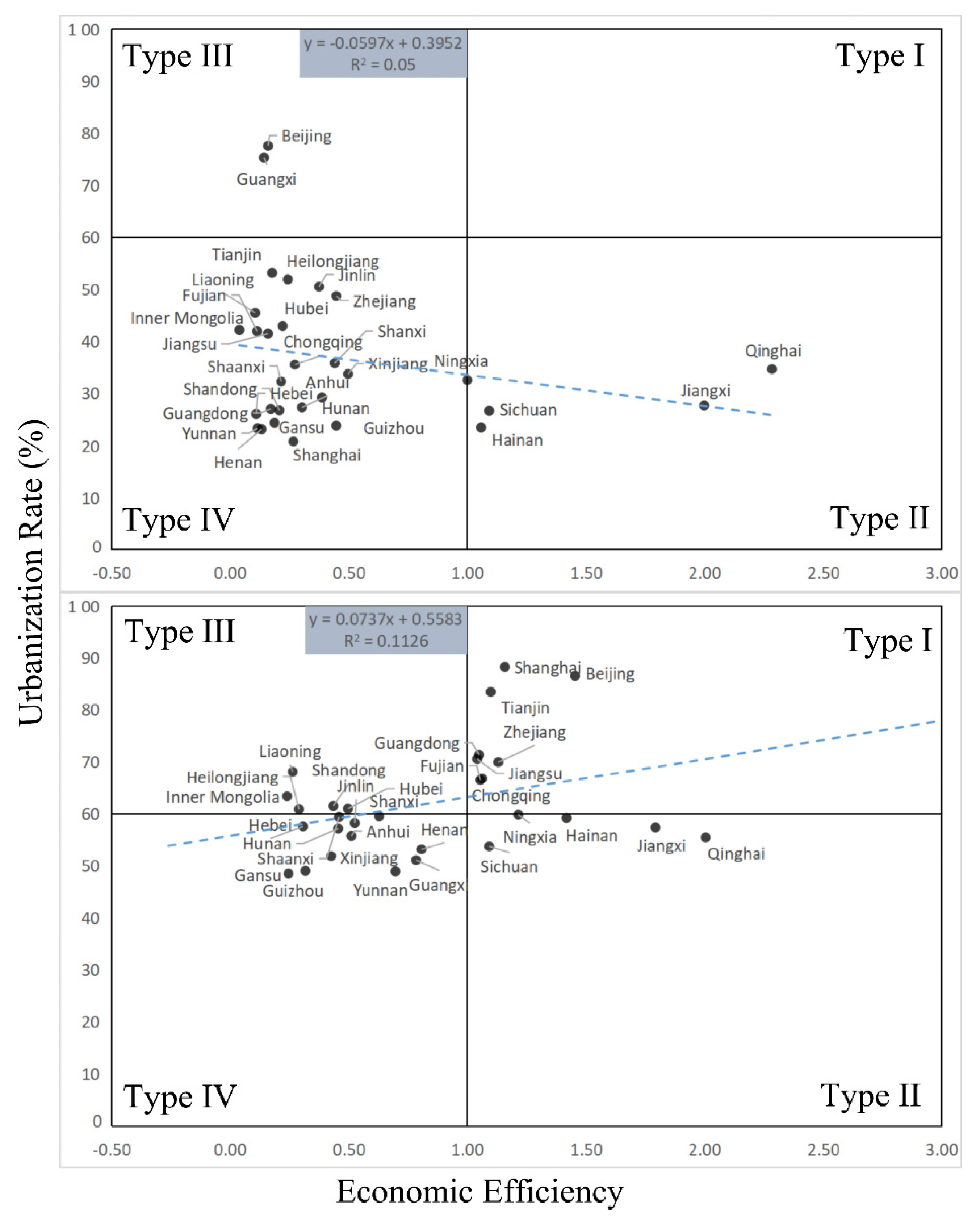
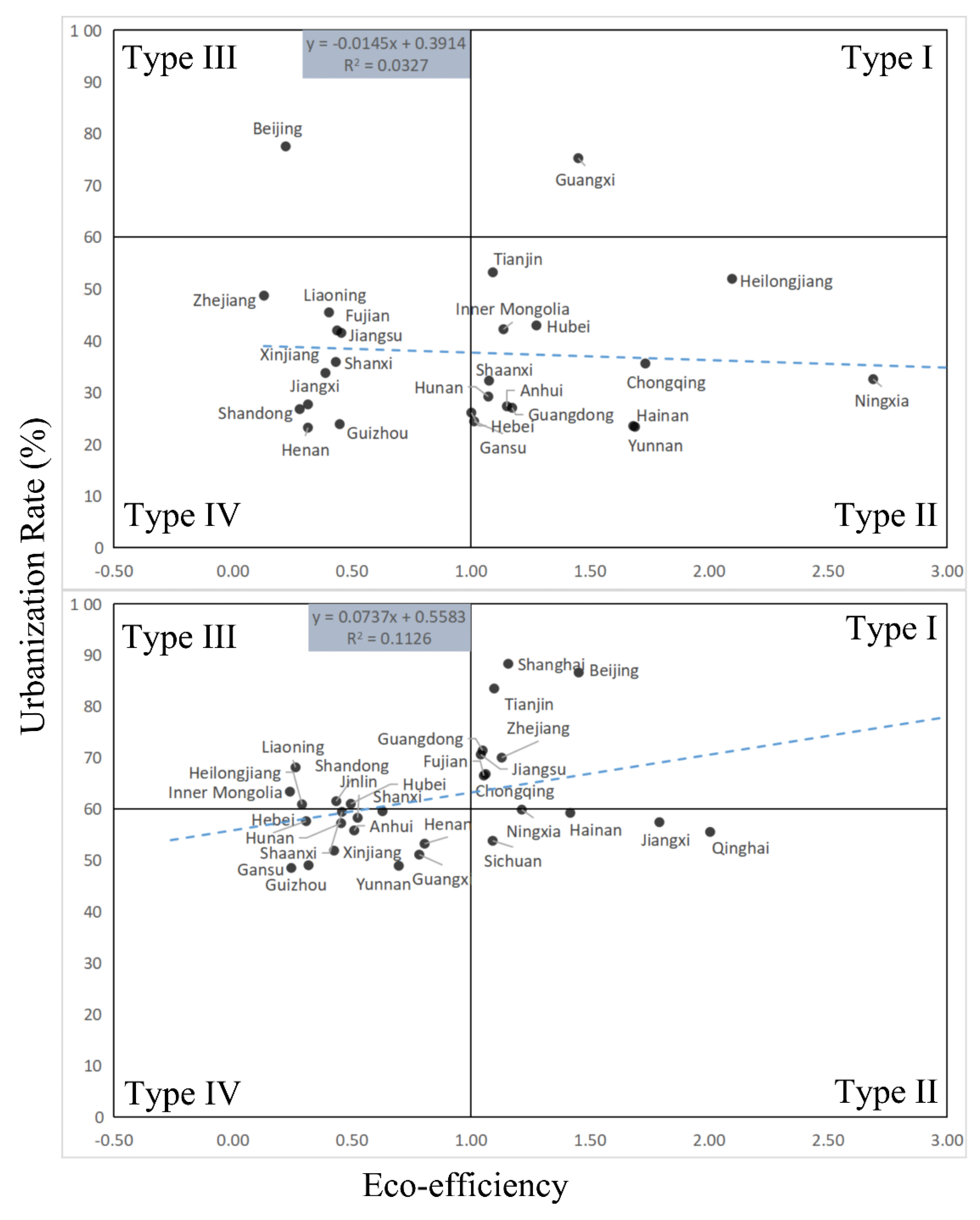
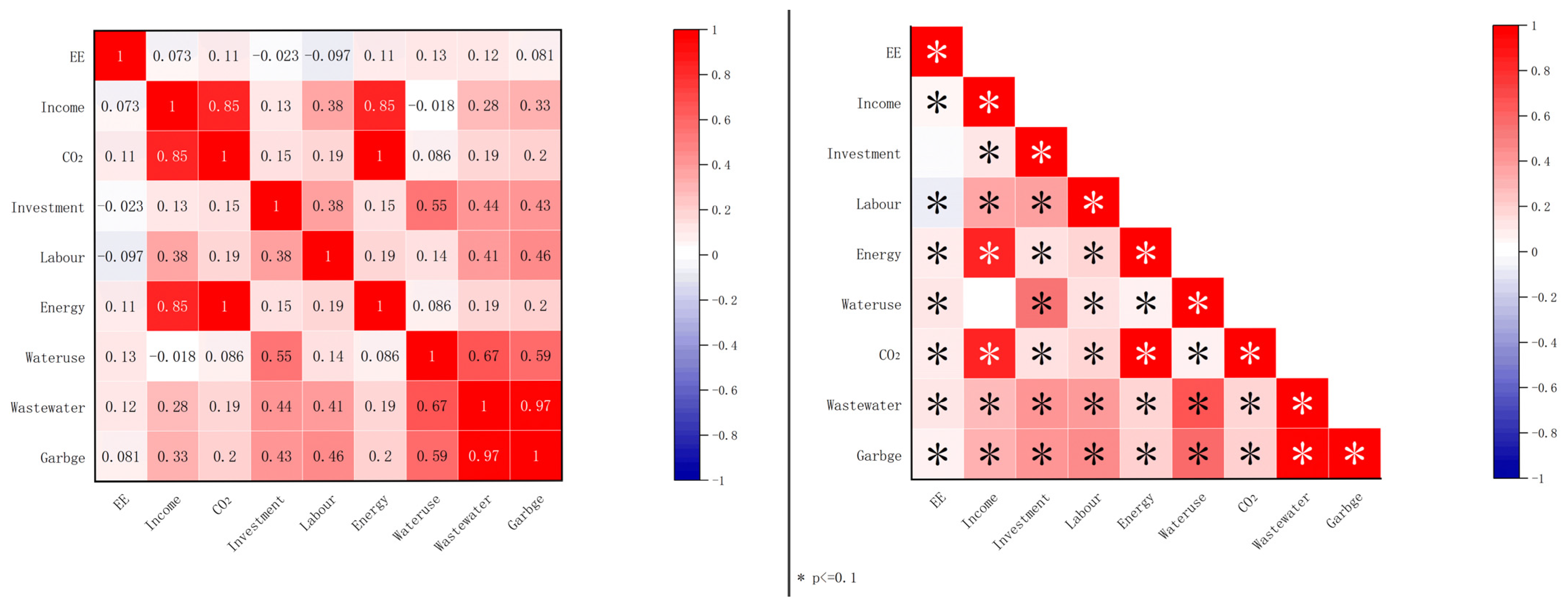
| Indicator | Unit | ||
|---|---|---|---|
| Economic efficiency | Input | The original value of fixed assets | Ten thousand CNY |
| Number of employees | Ten thousand people | ||
| Output | Income | Ten thousand CNY | |
| Eco-efficiency | Input | The original value of fixed assets | Ten thousand people |
| Total number of employees | Ten thousand CNY | ||
| Energy input | 10 k tons of standard coal | ||
| Water consumption | 10 k tons | ||
| Output | Income | Ten thousand CNY | |
| Undesirable output | Waste water discharge | 10 k tons | |
| Garbage discharge | 10 k tons | ||
| SO2 emissions | Ton | ||
| Carbon emissions | Ton |
| Variable | Obs | Mean | Std. Dev. | Min | Max |
|---|---|---|---|---|---|
| EC | 600 | 1.05 | 1.17 | 0.08 | 9.08 |
| EE | 600 | 0.63 | 1.36 | 0.01 | 15.77 |
| lnIncome | 600 | 11.61 | 1.82 | 3.46 | 16.72 |
| lnInvestment | 600 | 12.23 | 1.43 | 4.99 | 15.15 |
| CO2 | 600 | 4.51 | 12.97 | 0.01 | 258.03 |
| lnLabor | 600 | 9.10 | 1.33 | 3.04 | 12.11 |
| lnEnergy | 600 | 9.91 | 1.64 | 2.17 | 15.04 |
| lnWateruse | 600 | 5.64 | 3.23 | −3.54 | 10.34 |
| lnWastewater | 600 | 5.64 | 3.23 | −3.54 | 10.34 |
| Garbge | 600 | 6.36 | 1.80 | −0.16 | 10.58 |
| Variable | VIF | 1/VIF |
|---|---|---|
| lnInvestment | 4.91 | 0.20 |
| lnEnergy | 4.03 | 0.25 |
| lnWastewater | 3.96 | 0.25 |
| lnLabor | 3.35 | 0.30 |
| Garbage | 1.87 | 0.54 |
| lnWateruse | 1.57 | 0.64 |
| CO2 | 1.40 | 0.71 |
| Mean VIF | 3.01 |
| Variable | VIF | 1/VIF |
|---|---|---|
| lnGovfinancial | 8.79 | 0.11 |
| lnHousarea | 8.15 | 0.12 |
| lnTechmarket | 3.80 | 0.26 |
| Beds | 3.68 | 0.27 |
| lnTourists | 3.16 | 0.32 |
| lnPosts | 2.54 | 0.39 |
| Landscaping | 2.33 | 0.43 |
| Tertiary | 2.06 | 0.48 |
| lnPopudensity | 2.04 | 0.49 |
| lnPCWater | 1.38 | 0.73 |
| GDPSO2 | 1.34 | 0.75 |
| GDPenergy | 1.20 | 0.83 |
| Mean VIF | 3.37 |
| Type | EC | Conf. | z |
|---|---|---|---|
| Economic factors | lnIncome | 0.21 | 2.36 ** |
| lnLabor | −0.28 | −4.51 *** | |
| lnInvestment | −0.01 | −0.16 | |
| Energy factors | lnEnergy | −0.13 | −1.75 * |
| lnWateruse | 0.02 | 1.20 | |
| Environmental factors | CO2 | 0.01 | 2.82 *** |
| lnWastewater | −0.26 | −5.15 *** | |
| Garbge | 0.04 | 6.55 *** | |
| _cons | 3.78 | 8.56 *** |
| lnIncome | lnLabor | lnEnergy | Garbage | lnWastewater | |||||||
|---|---|---|---|---|---|---|---|---|---|---|---|
| Demographic characteristics | Population density | 0.18 | 4.24 *** | 0.11 | 2.80 *** | 0.09 | 1.95 * | −0.42 | −1.33 | 0.21 | 5.05 *** |
| Industrial structure | The proportion of tertiary industry | 1.73 | 2.41 ** | 1.42 | 2.25 ** | 2.90 | 3.81 *** | 24.55 | 4.99 *** | −0.81 | −1.21 |
| Technological | Technology market turnover | −0.15 | −3.98 *** | −0.14 | −4.25 *** | −0.22 | −5.62 *** | 1.42 | 5.39 *** | 0.10 | 2.90 *** |
| Social security | Number of beds in health institutions | 0.02 | 3.03 *** | 0.02 | 3.50 *** | 0.03 | 3.97 *** | 0.30 | 7.07 *** | 0.01 | −1.18 |
| Quality of life for urban residents | Housing area of urban residents | 0.60 | 5.98 *** | 0.38 | 4.36 *** | 0.41 | 3.80 *** | 0.89 | −1.28 | −0.03 | −0.31 |
| Total postal and telecommunications business | 0.46 | 4.12 *** | 0.09 | −1.00 | 0.75 | 8.37 *** | 3.09 | 6.15 *** | 0.48 | 5.47 *** | |
| Urban energy consumption | GDP energy consumption | 0.04 | 7.24 *** | 0.01 | −1.43 | 0.05 | 8.66 *** | −0.05 | −1.31 | −0.01 | −1.51 |
| GDPSO2 energy consumption | 0.34 | 4.76 *** | 0.11 | 1.82 * | 0.55 | 7.23 *** | 5.08 | 10.00 *** | 0.84 | 12.39 *** | |
| Urban resource and Environmental | Urban landscaping area | −0.02 | −1.94 * | −0.01 | −0.89 | −0.02 | −2.40 ** | 0.22 | 4.08 *** | 0.00 | −0.58 |
| Per capita daily living water consumption in cities | 0.39 | 2.51 ** | 0.16 | −1.18 | −0.10 | −0.57 | 4.04 | 3.56 *** | 1.03 | 6.86 *** | |
| Internationalization | Reception of international tourists | 0.04 | 0.78 | 0.16 | 3.85*** | 0.15 | 3.084 *** | −0.24 | −0.73 | 0.11 | 2.62 *** |
| The role of government | Local fiscal expenditure | 0.29 | 2.171 ** | 0.29 | 2.04 ** | −0.01 | −0.07 | −2.88 | −4.10 *** | 0.75 | 7.33 *** |
Disclaimer/Publisher’s Note: The statements, opinions and data contained in all publications are solely those of the individual author(s) and contributor(s) and not of MDPI and/or the editor(s). MDPI and/or the editor(s) disclaim responsibility for any injury to people or property resulting from any ideas, methods, instructions or products referred to in the content. |
© 2023 by the authors. Licensee MDPI, Basel, Switzerland. This article is an open access article distributed under the terms and conditions of the Creative Commons Attribution (CC BY) license (https://creativecommons.org/licenses/by/4.0/).
Share and Cite
Zhang, J.; Ba, D.; Dong, S.; Xia, B. Impact of Urbanization on Eco-Efficiency of Tourism Destinations. Sustainability 2023, 15, 10929. https://doi.org/10.3390/su151410929
Zhang J, Ba D, Dong S, Xia B. Impact of Urbanization on Eco-Efficiency of Tourism Destinations. Sustainability. 2023; 15(14):10929. https://doi.org/10.3390/su151410929
Chicago/Turabian StyleZhang, Jing, Duoxun Ba, Suocheng Dong, and Bing Xia. 2023. "Impact of Urbanization on Eco-Efficiency of Tourism Destinations" Sustainability 15, no. 14: 10929. https://doi.org/10.3390/su151410929







